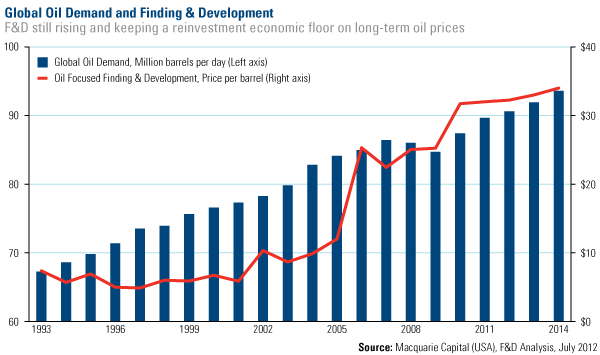Energy and Natural Resources Market Radar (July 16, 2012)

Strengths
- The yield on 10-year U.S. Treasury Notes closed at 1.488 percent on Friday, below the May Consumer Price Index of 1.7 percent, giving investors a negative real return. Comparatively, the Global Resources Fund’s portfolio currently has an average dividend yield of 3.75 percent.
- China’s GDP grew 7.6 percent for the second quarter year-over-year, slightly lower than expected, leading to a gain in copper and crude oil futures toward the end of the week. It seems that the market is expecting a stimulus to come about from China to offset all the pressures of slowing growth. The global financial crisis was the last time China’s demand slowed this much, having a GDP increase of only 6.2 percent during the first quarter of 2009 year-over-year.
- Corn prices hit 52-week highs this week after the U.S. Department of Agriculture estimated a drop in crop yields of 12 percent, the largest month-over-month drop in nearly a decade. Jerry Norton, chair of the Interagency Commodity Estimates Committee, stated that “It’s a very unusual situation.” Only 40 percent of the nation’s corn crop is in good to excellent condition, significantly lower from last year’s 69 percent rating.
- Oil prices (Brent) gained over 4 percent this week to close at a six-week high of $102.76 per barrel as hopes for additional stimulus from the Chinese government boosted sentiment.
Weaknesses
- Statoil was set to shut down operations until the government of Norway intervened on the 16-day oil strike, putting an end to the restriction of supply that was driving up oil prices. The workers were forced back to work and the National Wages Board will attempt to resolve the conflict.
- Although China imports were up year-over-year in June, they increased by only 6.3 percent, less than half of forecasts, contributing further to an already stressed demand with regard to commodities. One factor of the increase in China’s trade surplus can be attributed to the excess stockpiling measures China took before Indonesia’s export tax on metals went into effect in May.
- China’s main coal mining provinces have plans to cut back on output in an effort to alleviate market conditions. According to Platts, a number of Shanxi-based miners have already cut output by 20 to 30 percent since May.
- U.S. net new aluminum orders fell sharply in June, according to data released from the Aluminum Association. Aluminum orders (less can stock) fell 4.4 percent year-over-year in June.
Opportunities
- China Copper Mines has applied to exploit five mineral waste dumps in Zambia which may have a yield of 600 metric tons of copper cathode per year. This project will increase China’s presence in Zambia, Africa’s largest producer of copper.
- Julio Velarde Flores, President of the Central Reserve Bank of Peru, commented this week on the growth prospects of the country. He is optimistic and believes they can exceed the economic growth targets for the year. Peru, the world’s second largest producer of copper, is in the process of seeking investment from wealth funds in Singapore.
- Anglo American has reached a deal with the government of Moquegua to build a $3 billion Quellaveco copper mine, according to Oscar Valdes, Prime Minister of Peru. 220,000 tons of copper per year is estimated to come out of Quellaveco, which is close to one-fifth of Peru’s 2011 total output.
Threats
- By 2016, the Democratic Republic of Congo hopes to triple its current output of copper to 1.5 million, according to Mines Minister Martin Kabwelulu. The Congo has about half of the world’s cobalt reserves, and is aiming to boost output by 65 percent. The government, however, plans on increasing the state’s stake in mining operations which will be used to promote the growth of industry, the country, and its people.
- According to Reuters, Baoshan Iron & Steel, China’s biggest listed steelmaker, will cut August prices of its main products by 4.6 percent as seasonal demand slows. Global Times recently reported that China’s domestic steel prices hit two-year lows during the first week of July. Until we see more quantitative easing in China, we will be unlikely to see any large gains in steel prices in the near future.
- The U.S. Energy Information Administration lowered its 2013 forecast of global oil demand to 730,000 barrels per day. The International Energy Agency however took a contrarian viewpoint with their forecast, estimating that oil demand would rise by one million barrels per day, 1.1 percent higher than in 2012, but still lower than levels seen prior to the financial crisis.













